A Forest of Questions
Lindsay:
September 6, 2010
I slept outside last night to continue in my Sunday appreciation of the clouds drifting out of reach of even the mightiest of Doug firs and woke this morning to an odd rustling in the leaves of the oaks. But the rustling was too close to be coming from the oaks and I realized it was rain drops breaking on my blankets. As I moved my bedding inside, I encouraged the rain to soak deep into the soil, but the light shower only lasted a few more minutes before the clouds dried up.
We've had a few of these light sprinkles, unusual for August and early September, and with this unexpected moisture combined with some night time temperatures down into the low 40s, we are reminded that indeed fall is on its way, and winter soon to follow.
a high density part of our forest
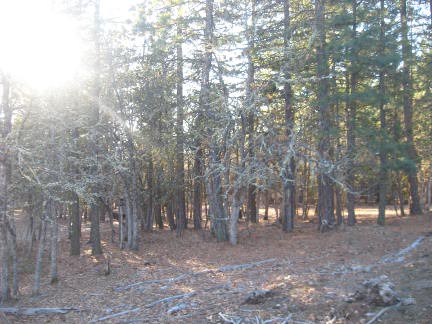 |
| |
Last week, there was a wildfire that burned in the oak forests above the Klickitat River for about four miles up from the Columbia. The cooler temperatures and the rains countered the blustery winds to help the fire fighters suppress the flames, but it was nonetheless anxiety provoking to have a blaze so close to home.
Thankfully it was mostly a grass fire, and didn't burn much in the forest canopy. The forest in this section was already fairly low density, as the shallow soils and steep incline allow for only the hardiest of trees to win out in the competition for limited resources. The remaining charred ground on the hillside also serves as a good reminder as to why it is we are doing the work in our forest to reduce fire fuels, the work that has kept us busy through fall, winter, spring and summer and soon fall and winter once again.
Fire is a natural part of the ecology in the forests of the Pacific Northwest (PNW), particularly in these transition forests of Oregon white Oak, Douglas Fir and Ponderosa Pine that we call home. Prior to human modification, the fires would mostly start from lightening strikes, but now they are caused by downed power lines, reckless campers, sparks from chainsaw blades, even a glass bottle can concentrate the sunlight just right to ignite a flame.
part of our forest after thinning
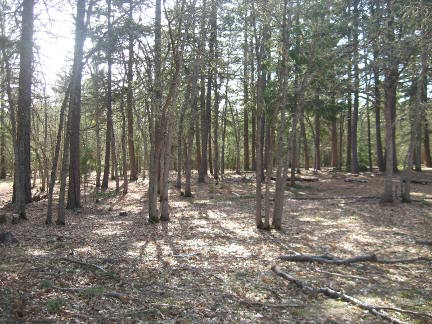 |
| |
And again, prior to human impacts, fires (along with major storms) were the primary disturbances to the forest, the disturbances that restart the processes of succession, a necessary part of a dynamic and healthy forest ecosystem. In the PNW, humans have added logging as yet another significant disturbance, and here at Windward this land was likely only logged once, about 100 years ago.
So the forest that we inhabit has been shaped by thousands of years of fires and wind storms, and more recently by logging, but has been relatively unmanaged for the past century. We are lucky in this sense, as this enables us to see nature's processes first hand, learn from them, and incorporate these processes into our own land management techniques.
However, the lack of management does mean that a significant fuel load has built up over the years, and tree density is higher than is optimal for tree health and growth. In a world without humans, fire and time would resolve these issues and begin to create the old growth forests that the first European explorers were so in awe of‒the dead branches would eventually burn or otherwise decay and the dense clumps of trees would likely remain slow-growing for many years until some event (fire, storm, disease) came through and selected the few that would grow to maturity and the rest would become fertilizer for the forest floor.
However, we would prefer to not have an uncontrolled fire sweep through our forest (particularly in the crown of the trees, as crown fires can be the most challenging to control and they are the most damaging to the forest) nor do we want the trees to be stressed by high density, so we have been thinning and limbing a portion of the forest over the past year or so.
Most second (or third or fourth growth forests) are over-stocked, meaning there are too many trees growing in close proximity to each other, so they compete more than necessary for resources (e.g. light, water, nutrients), grow slowly and are quite prone to disease or damage (from fire or insects or storms). Much of our forest here is no exception, and the current best understanding of optimal distances between trees of the species we have here is about 10-15 feet (crown edge to crown edge for fire safety and from trunk center otherwise).
So while I still consider myself a lover of trees, I realize that I am more a lover of forests. For in order to encourage the forest into a healthy and dynamic state of growth and death, germination and decay, many trees need to be cut down. To be able to take chainsaw to tree and make dead what was once living, I have come to stand by my firm belief in the cycles that make forests the dynamic source of life that they are.
Previous notes articles have talked about what we have been doing with the material generated, from making crafts to fertilizer to fuel, but here and in writings to come I am going to focus a little more on the ecological impacts of what we are doing and the implications it has and questions it raises for the future of our forest.
a single Oregon white oak tree
 |
| |
Oregon White Oak and its Nine Lives
One of my favorite things to do when walking through the forest is to look for the forest that used to be. Once you gain some portion of an understanding of how each species grows and responds to different disturbances, you can use the patterns of the existing vegetation and landscape to begin to see the trees and shrubs of years past that grew and died in such a way to enable the current forest to grow in its place.
Perhaps the most prevalent example in our forest is that of the clumps of Oregon white oak. Oregon white oak, or the garry oak (Quercus garryana) sends up suckers (new saplings sprouting from the same root system) when there is a disturbance to the primary tree. (Its the tree's way of saying, "Hey, I've got a job to do, so gosh darn't I'm going to do it!") So, when walking through the forest now, you often see clumps of three to eight oaks growing quite close together, and often in some semblance of a circle.
an oak circle
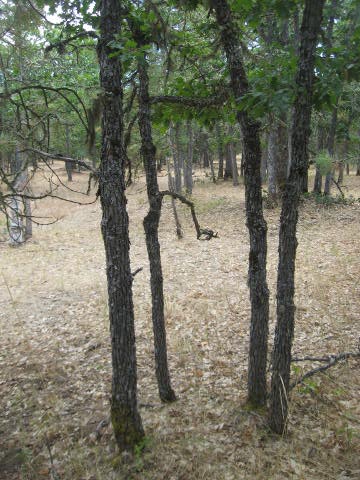 |
| |
The space at the center of these trees is where the previous tree used to be, and when it died (likely when the land was logged approximately 100 years ago or perhaps from a fire) there were phytohormones that triggered multiple new shoots to sprout up from the base of the tree. These many shoots likely formed an oak "bush" made up of 10 or more stems, until a few trees over time had enough accumulated advantage to grow into trees, while the many other stems died away.
This response of the Oregon oak to being cut informs how we manage. For example, many of the trees we cut this spring to decrease forest density have already sent up suckers around the base. So, when walking through the forest you can see the many stages of oak development:
- the grand oak standing alone
- the recently cut oak with many suckers sprouting
- the several year old oak "bush"
- the one or three small (5ft high) trees surrounded by oak "bush", and
- the clumps of well developed (30+ feet high, several inches in diameter) trees.
an oak stump putting up suckers
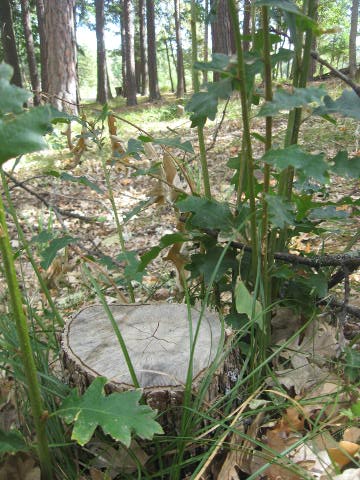 |
| |
If we left these newly sprouting shoots to continue to grow, they would continue through this process until a new clump is formed. However there are other options as well. We could let the sheep and/or goats graze these new succulent shoots, if we want to keep the forest density as it is or encourage the remaining trees to grow larger and prevent regrowth. Or we could select a few shoots to regrow and cut back the remainder, to essentially just increase the rate of nature's clock.
The timing of the initial cut is important to keep in mind as well. Oaks cut in the spring through the summer are more likely to send up suckers than those cut in the fall or winter. So, if we want to continually manage a portion of the forest, say, for mushroom logs, or firewood, or a certain sized tree for wood working, then we would want to cut in the spring to encourage suckering (regrowth), and if we wanted to discourage this process, we would be better off cutting in the fall or winter.
another oak stump putting up suckers
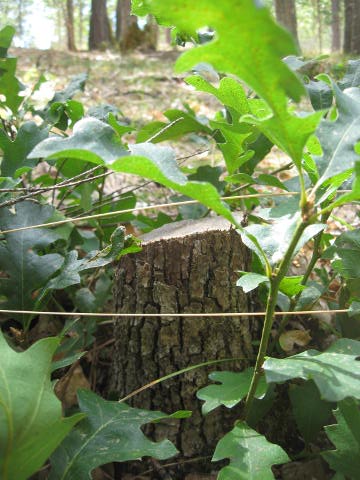 |
| |
Forest management is a long term endeavor and it is humbling to think how our actions and decisions now will have implications far into the future for the health of this land and for the lives of those who call it home. I often find myself searching for another word besides "management" to describe our endeavors here, as this word seems to convey more alteration than we aspire to.
So, I will settle, for now, with stewardship. To the degree, however, that our actions now do help shape the forest of the future, I want to share my current guiding philosophy: to increase the health, productivity and diversity of the forest. Essentially this translates into we want a little bit of everything in our oak forests:
- some oaks that grow into large spreading trees, as these are the trees that produce the most acorns (for wild and domesticated animals alike) as well as the trees that when they hollow out (a result of fire) form cavities for a variety of bird species
- some oak clumps that are routinely cut (every 30 years or so) and encouraged to sucker for mushroom logs, fire wood, wood working, and biomass
- areas of low density trees that create a more savanna like ecosystem where native grasses and wildflowers have more sun
- areas of high density trees that serve as cover for wildlife and for shade loving understory plants
- mixed aged stands, including dead and decaying wood and newly germinating saplings.
an oak "bush"
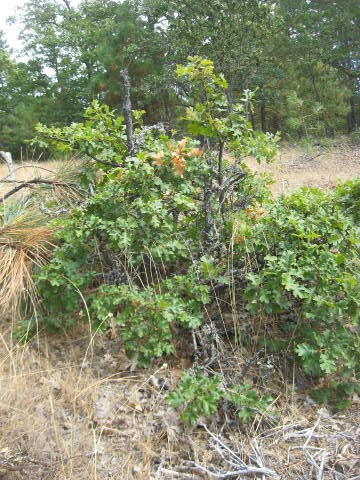 |
| |
In the process of trying to encourage this diversity, we want to try to do as little as possible to disturb the processes already in play, the processes of which we may understand very little. I am drawn to the words of Aldo Leopold here as his thoughts convey much of how I feel regarding this endeavor of stewarding such a complex and dynamic ecosystem that continually causes me to ask more questions than it provides answers.
"The outstanding scientific discovery of the twentieth century is not television, or radio, but rather the complexity of the land organism. Only those who know the most about it can appreciate how little we know about it. The last word in ignorance is the man who says of an animal or plant: "What good is it?" If the land mechanism as a whole is good, then every part is good, whether we understand it or not. If the biota, in the course of aeons, has built something we like but do not understand, then who but a fool would discard seemingly useless parts? To keep every cog and wheel is the first precaution of intelligent tinkering." (A Sand County Almanac, and Sketches Here and There, 1948)
an oak cluster
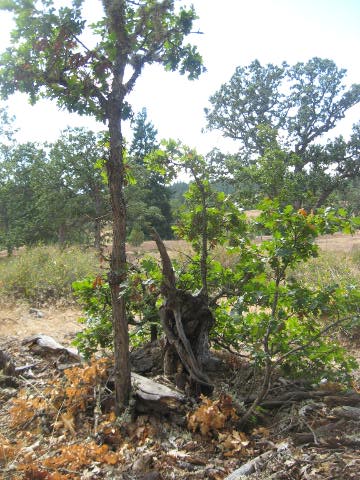 |
| |
December 11: Ponderosa Pine and Fire Ecology
On much of the property, Ponderosa pines stand tall and stately, and when beneath one of the 100+ year old giants, the reason for its name (in Latin ponderosa means "heavy, weighty or significant") is easily understood. While "ponderosa" is currently its most common name, this tree is referred to by many names throughout the west, including yellow pine, bull pine, blackjack pine and rock pine. So many names for a single tree can be confusing to those interested in natural history or learning about the ecology of the local region. Yet, I'm going to add to the list yet another nick-name for the tree, the Puzzle-Bark Pine, as its bark forms in interlocking and curving layers, to create quite a complicated natural jigsaw puzzle. It is its visually captivating bark structure‒its thickness and the ability of single plates to flake off during extreme heat‒ that make ponderosas particularly well adapted to a landscape shaped by fire. (Though the details and importance of this last mechanism is not well understood).
interlocking "puzzle" bark of a Ponderosa pine
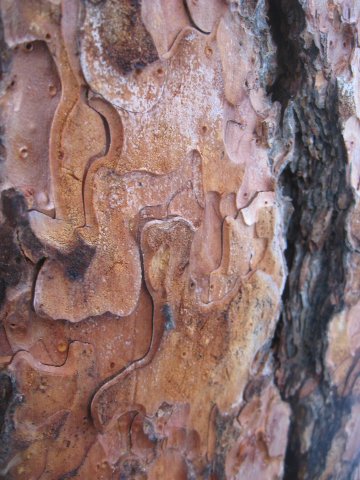 |
| |
Young pondies (yet another affectionate name for ponderosas), are far from fire resistant, as the outer layers of the bark have not thickened sufficiently. So the phloem (the cells of the tree's wood that transport nutrients and sugars and are necessary for tree survival) is close to the surface. While mature ponderosas will likely survive all but the most severe of forest fires, young ponderosas will add fuel to the an otherwise low intensity blaze.
a clump of young Ponderosas before thinning
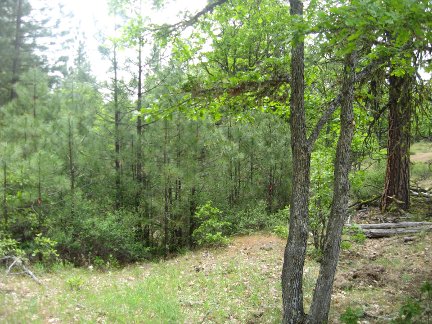 |
| |
So, we have been thinning out ponderosas that are under nine inches in diameter at approximately four and half feet off the ground (foresters and ecologists refer to this measurement as DBH‒diameter at breast height). As with the oaks, thinning out these smaller trees so they stand 10-15 feet from each other increases the resiliency of the remaining trees as they are able to take in more of all the essentials (water, light and nutrients). This process, though somewhat counter intuitively, also encourages the growth of a forest with different aged trees, which is beneficial from a variety of perspectives. When a large scale disturbance comes through, whether it be fire or logging, the clock is reset for the land all at once, and the result is a forest of trees that are all approximately the same age. These so-call even aged stands have lower structural diversity (e.g. large trees with broken tops that raptors favor for nests near a clump of densely growing young trees that serve as cover and shelter for four-legged wildlife), have lower mycological and bacterial diversity (e.g. vegetation in varying stages of decay provide homes and jobs for a variety of fungi and bacteria and therefore enable such necessary links in the nutrient cycle to stick around), and are less attractive from the perspective of long-term, low intensity human use (e.g. if you plan on using the trees in the forest for home lumber needs, you want to consistently have trees at varying levels of maturity). By thinning out some of the densely growing trees, we are opening up space, light and nutrients for new trees to germinate and thrive that would otherwise be choked out by the lack of resources.
There is a common association made between the size of a tree and its age that can be misleading when thinking about forest dynamics. While it is true that it takes many years to create a forest giant, the kind of tree that you gaze up at, mouth agape, in awe, and a smaller diameter tree standing adjacent to such a forest giant, is not necessarily significantly younger. For example, earlier in the fall, I was cutting ponderosas eight to ten inches in diameter that were growing literally within inches of ponderosas two to three times that size. Despite the difference in diameter and height, I would venture to say that they these trees germinated within ten years of each other.
three Ponderosas that are probably approximately the same age
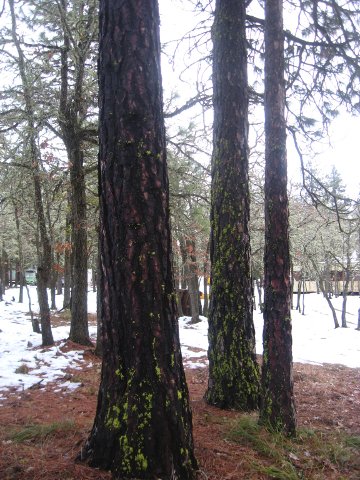 |
| |
While I cannot know for certain without taking a core of the still standing trees (this is one method that is used to determine the age of a living tree), the smaller diameter trees are a little over 100 years in age (information gathered from counting the rings on the stump), which is about how long ago this land was logged. So, it would make sense that these trees either germinated soon after the land was logged or were too small to bother with when all the larger trees were cut and removed. Maybe it was a better set of genes, maybe one tree had a little bit of a head start, maybe one was slowed down by herbivory or storm damage, or likely some combination of the above, but nevertheless, the larger trees have successfully accumulated a little more light, a little more water and a little more nutrients year after year after year and the result has been faster growth.
Removing these smaller diameter, century old trees, is a humbling process, and not one that I take lightly. But it is reassuring to know that while they have survived next to their big brother, their growth has been and continues to be ever so stunted. Removing these smaller trees creates that many more resources for the remaining trees and soon-to-be germinating trees to take advantage of. Also, many of these slow growing trees are often less desirable for lumber because of odd curves or kinks in the trunk and a higher density of knots from closely grown branches (I should note here, however, that slow growing trees that have evenly accumulated wood around the center are quite good for lumber, because the higher density of rings leads to stronger structural integrity. This is more likely to happen when trees are evenly but densely distributed spatially across a landscape).
Ponderosas go through a process called self-pruning, which we are essentially increasing the rate of by limbing. As a tree matures in a forest, the lower branches and the needles that they support become less effective as solar collectors due to low light levels closer to the forest floor. As it becomes less efficient for the tree to allocate resources to these less productive lower branches, the branches die. In some trees, these branches remain connected to the tree. However, pondies shed these lower, dead branches, and are thus considered self-pruning. In our efforts to reduce ladder fuels, we are limbing branches up to 20 feet high (the height of our longest pole saw), or up to 1/3 of the height of the tree. Given enough time, ponderosas would do this on their own, but since we want to to reduce the risk of stand replacing fires now, we are speeding up the process.
Self pruning in process: the bottom quarter has no branches, then a few feet of dead branches still attached, and the top 2/3 of the branches are alive and photosynthetically active
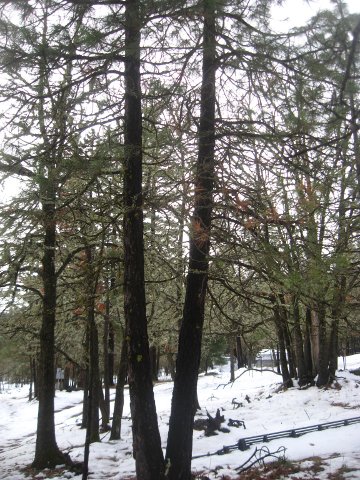 |
| |
Unfortunately, throughout the inter-mountain west, pine forests are far from balanced systems. Decades of fire suppression, aggressive logging and under-informed management have undermined the mechanisms that have evolved to enable forest ecosystems to maintain a relative dynamic equilibrium.
(If you have a moment, take a breath or two to let this concept settle. It's absolutely remarkable to realize that healthy forests are effectively self managing systems made up of a multitude of complex individuals functioning through an interconnected network that we can only strive to understand, little by little. Over the years, society's sometimes well intended, and sometimes thoughtless actions have disrupted this network and disturbed some of the stabilizing feedback mechanisms. The result is a system struggling to regain a state of dynamic equilibrium. We can see a similar process in play on a smaller level, such as with the health of the human body, and on larger levels, such as the entire earth system, and in all these scenarios it is similarly fascinating the wonders of how the system works and saddening that humans have been interfering with these self regulating feedback mechanisms.)
One of the manifestations of a pine forest no longer in dynamic equilibrium is the increasing frequency and severity of bark beetle outbreaks. It is more and more common to see broad sections of pine forests dead and standing as an unsettling reminder of our role in pushing these magnificent forests out of balance. Unlike so many of the species that plague forest systems, bark beetles are native to the conifer forests of the northwest. These insects are even considered to be part of a healthy forest, as, amongst other contributions, they help cycle nutrients (causing large, old trees to die which creates dead and decaying wood), and create habitat and food sources for a variety of species (many birds create nests or feast on the bugs in large dead trees). However, when individual trees are moisture stressed (from such conditions as high density and soil compaction) they become far more susceptible to bark beetle invasion. And as bark beetles are more successful in their reproduction the potential for a population explosion increases.
We do indeed have bark beetles in our forests here at Windward as indicated by the galleries formed on trunks and branches, as well as the pitch tubes that the trees create as a defense mechanism against the invading beetles. Efforts to decrease the density of trees and thereby increase the moisture that is available to those remaining, improves the tree's resiliency and protects against stand replacing bark beetle invasion. Every year we do have a few ponderosas die that have been invaded by bark beetles and hopefully these efforts will help maintain the rate of tree mortality at an appropriate level.
resin extruded from a Ponderosa fighting bark beetles
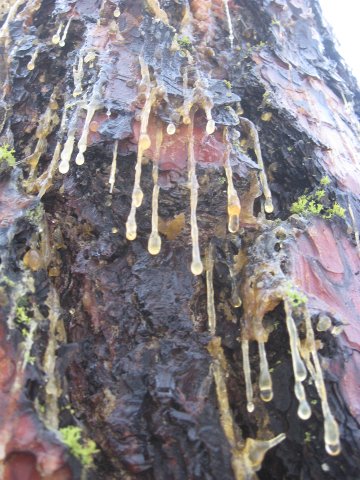 |
| |
When trees do succumb to the bark beetle, the bark beetles are usually aided by a partner in crime. Bark beetles enable the spread of a fungus that blocks the flow of water and nutrients through the tree which thereby compounds further the tree's moisture stress. A tree's ability to access and distribute moisture is directly related to it's ability to fight the invading bark beetle through resin production, so the fungus further decreases a tree's vigor and enables the spread of bark beetles in a reinforcing feedback loop. This fungus also happens to create a blue stain in the wood of the trees that it infects, which is actually quite attractive (blue pine) for use in woodworking if recently fated trees are harvested.
Bark beetles are most active during the late winter through the summer and so thinning pine stands is best done during months of low level bark beetle activity‒mid August to mid February in our region. It is important for us to abide by nature's clock in these efforts, or we might inadvertently create more problems than we are creating solutions.
And finally, I want to take a moment to honor the sometimes lesser celebrated components of the ponderosa forest. In the previous article on oaks, I referenced Aldo Leopold's notion of "intelligent tinkering" and preserving every cog and every wheel of a system regardless of whether we understand its precise function. Mycology‒or the study of fungi‒is contributing an increasingly fascinating twist to our understanding of forest dynamics from the perspectives of nutrient cycling to inter and intra-species communication. Yet most of the work that fungi do is performed underground, out of sight of humans. To put into perspective a little of what we rarely see, ponder some of these numbers‒in a single gram of soil there exists: 10 million to 100 million bacteria and actinomycetes, 1,000-100,000 fungal propagules, and several kilometers of fungal hyphae (Diversity, Ecology and Conservation of Truffles in the Pacific Northwest, 2009)! And what the casual observer usually sees is just the fruiting mushrooms when the rains come and the temperatures are just right.
In the spring and in the fall, when the temperatures are mild and the ground moist, our forest abounds with mushrooms. We are far from being able to identify them all, but we certainly have been quick to identify a few of the edibles and beneficial mushrooms such as puffballs, slippery jacks and morels. The plentiful fruiting bodies indicate that our forest supports a wide array of fungi‒with mycelium that, beneath the leaf litter, likely covers much of the forest floor. These fungi are supported by various stages of rotting and decaying wood and organic matter. To maintain a home for this diversity of fungi, it is important to keep dead and decaying wood on the forest floor even in the areas where we are thinning and reducing fire fuel hazards. This coarse wood varies from small branches (which are scattered throughout) to entire tree trunks (which can be stacked in piles, with 1-2 stacks per acre). Our hope is that while we are removing organic material from the forest to reduce forest fires at a rate that is faster than nature's regular schedule, that we do not disturb too greatly the forest's balance of decay.
an oak "bush"
 |
| |
Notes From Windward - Index - Vol. 70
|
|












